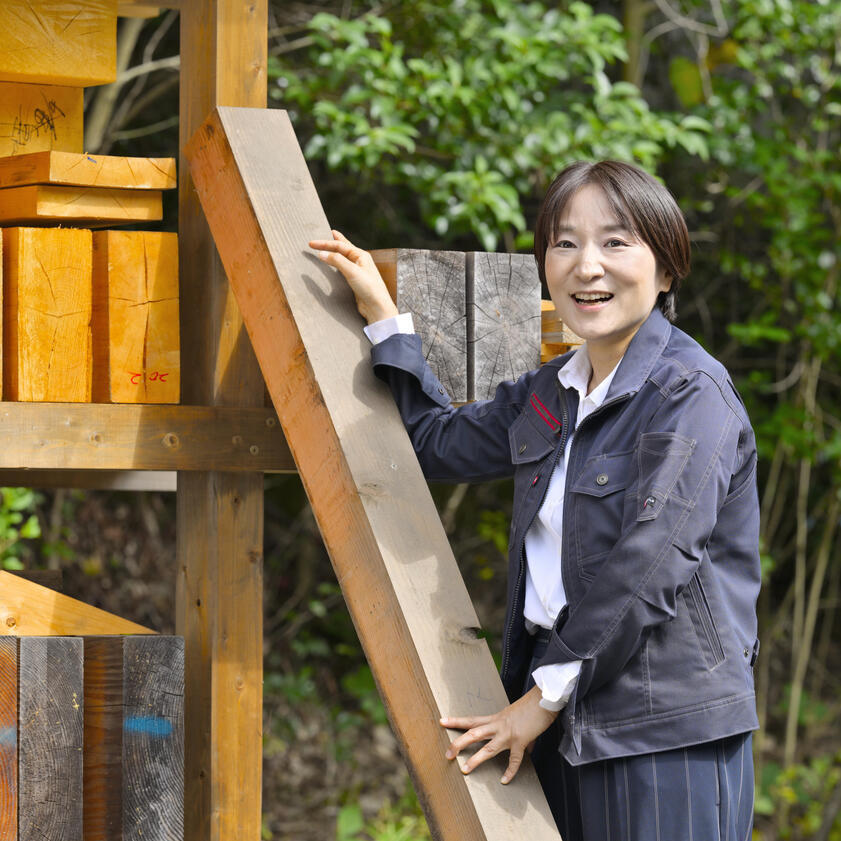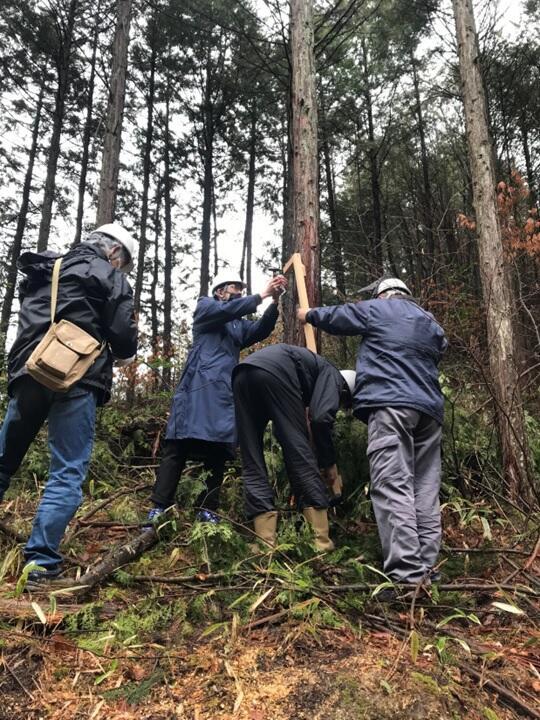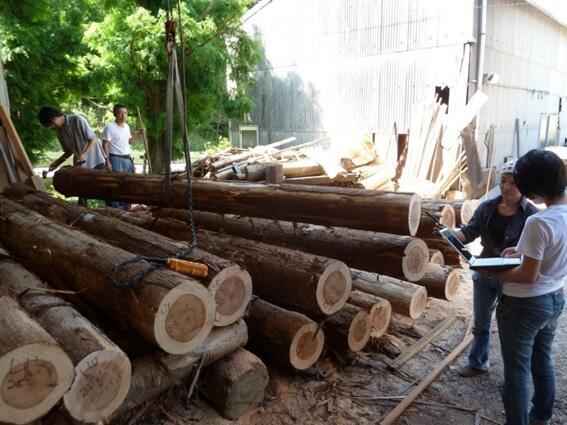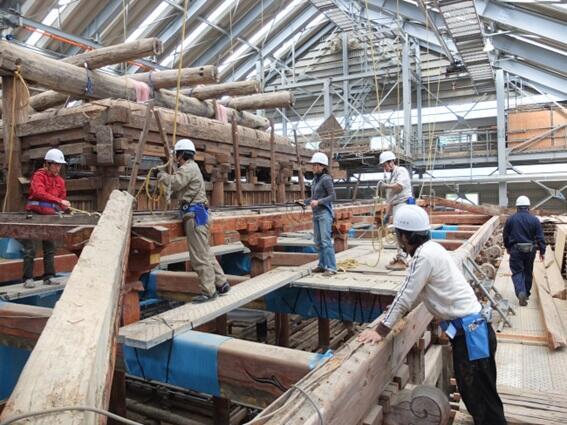Professor Ryuichiro Higashinaka

Researchers'
Professor
Mariko Yamasaki
Graduate School of Bioagricultural Sciences
Wood is a material that connects forests and cities. Both forests and cities spend great lengths of time, on the order of decades or centuries, growing and creating societies. When we face forests, wood, and buildings, we learn from them about the lives of the local community at that time, and we reflect on the minds of those who came before us, the people who planted the seedlings and who worked on the construction of the buildings. Wood transcends time to provide us, modern people, with these opportunities, and we are the ones who pass these opportunities on to future generations.
Timber engineering is the study of how we can incorporate and use timber in our everyday lives in order to cultivate healthy forests and enrich human society. I place great value in "learning from the past" to deepen my knowledge, while always being aware of my responsibility to history and to the future.
Today, environmental problems are becoming increasingly severe, and human society is facing many difficult issues. I want to conquer these difficulties and pursue my research and education with a smile on my face, trying to create a future where we have made even just a little bit of progress. I am grateful to be able to live my life this way.
I’m doing research on timber engineering.
I conduct research on the mechanical uses of lumber, particularly construction timber that comes from planted forests. For example, trees are living organisms, so each and every tree has different mechanical properties. Even within a single tree, when different parts of the tree are sawn to produce timber for buildings, each part has different mechanical properties, and how timber is sawn also affects the mechanical properties of the lumber being produced. In my research, I investigate the distribution of mechanical properties in wood in order to utilize as much of the wood as possible in buildings. In planted forests, overusing and underusing trees both degrade the environment. Meanwhile, wooden buildings continue to be players in cities spanning lengths of time on the order of decades or centuries. I believe that it is extremely important to consider the balance of supply and demand for wood not only for today, but also in the coming decades and centuries.

Measuring the properties of standing timber in a planted forest (stress wave method)

Measuring the Young's modulus of Japanese cedar logs
using the axial vibration method (at the Toyota Forestry Association)
As trees grow, they assimilate carbon from the air by photosynthesis. So, as long as trees are not burned, the assimilated carbon is stored in the ground. Using wood in buildings is one way to reduce carbon dioxide emissions. Recently, there has developed a renewed interest in wooden buildings around the world, which has stimulated the development of new styles of wooden buildings and technological innovations. In order to increase the value of this type of wood use, it is essential to extend the service life of wooden buildings. For the past twenty years, my laboratory has been conducting mechanical studies of old wood materials to evaluate the durability of wood materials, testing them under various loading conditions. We are also developing a measurement method to evaluate wood being used in buildings, right where it is in the building.

During the renovation of an ancient temple, checking the properties of
wood used in the temple for centuries
I was born and raised in Hyogo Prefecture. I was interested in the wood used in former residences of foreign settlers, called Ijinkan, and in schools there, and so I wanted to study wood science. For that reason, I enrolled in the Department of Forest Products at the School of Agriculture at Nagoya University. At my lab, I found that everyone was applying some kind of force to wood to measure how it would deform. I didn't really have any idea what I was doing, but I conducted my own experiments anyway. Then, one day, I was suddenly swept by the feeling that doing mechanical tests on wood was enormously fun, and I became obsessed.
Each piece of wood has different mechanical properties depending on which tree and which part of the tree it comes from, so each test piece of wood behaves slightly differently. Needless to say, a proper testing technique is necessary to get an accurate result for each piece of wood. Even a tiny slip-up can produce results that reflect not the properties of the wood, but your own experimental errors. It is only by conducting our experiments seriously, giving each and every specimen the respect it deserves, that we can consider the causes of variance in the experimental results—in other words, the mechanisms underlying the mechanical behaviors of wood. I also do analysis through repeated trial and error, looking for clues in a variety of materials sciences, and several times a year, I can hear something like the voice of the wood. I feel like I've achieved some sort of connection with the silent wood. I suppose you could say that I treasure these moments. That’s probably why I decided to do this research.
I always think research is interesting, but if I had to say, then it would have to be those moments when I make that connection with wood. It's natural that if you do such-and-such experiment, you’ll get such-and-such results. But I think the real thrill in research is digging up something that was previously invisible. For example, when I do research on old wood, I often get the same results that I more or less expected: “Old wood is supposed to behave this way.” However, I also occasionally realize, “Wow, old wood behaves that way too!” I have a lot of fun trying to come up with a hypothesis that will satisfy both of these results in light of previous findings.
The Center creates wisdom that is greater than the sum of its parts by bringing together a variety of researchers in the fields of engineering, agriculture, and science so they can consolidate their efforts to contribute to a carbon-free society. I believe that the opportunity to have these encounters with initiatives in other fields that you wouldn't usually have the chance to learn about helps foster innovation for a carbon-free society. Furthermore, the Center has connections not only within the university, but also with businesses and governments, so we have high hopes that the Center will serve as a conduit for the implementation and contribution of our research achievements to society.
* Nagoya University Research Center for Net-Zero Carbon Society (in Japanese)
https://www.zcs.mirai.nagoya-u.ac.jp/
Building a carbon-free society is an absolute must for the future of people living on Spaceship Earth. The society of the future will be very different from the society we think of as normal today. This is a chance for you to create a prosperous future for the global environment and for human society! Imagine what kind of society will give you and your children a reason to smile. Do not be ensnared by ideas of what is "normal"; keep a flexible mindset as you advance, step by steady step, toward a bright future.
As a graduate student, I was obsessed with aerobics, so I spent all my time either in the lab or in the studio. Moving to the music refreshed both my body and my mind. At the gym, I made friends with people of all ages and occupations. We are still good friends now. I think it was a valuable experience for me to be able to connect with a diverse group of people outside of the university.
Recently, I've enjoyed spending my time wearing kimono, watching plays, and doing handicrafts—the hobbies of a homebody, I suppose you could say. This year I've gotten hooked on knitting socks by hand. It's not uncommon for me to spend my big holidays at home, immersed in knitting. Something else that makes me feel refreshed—not just on my days off, but even just when I'm on my way to work—is when I look up and feel the seasons in the colors of the sky. When the weather is nice, I also like to walk around the city. So maybe I have an outdoorsy side, too. I want to cherish the time I spend feeling the rays of the sun, the sound of the wind and the rain, and the smell of the greenery and soil in my garden.
Ever since graduate school, I've had cats that I adopted from the shelter. I can spend all day cat-watching and never get bored. I think I’ve learned a lot about life from their interactions with people and other cats.

Her cat is always fascinated when she uses the sewing machine.
(The cat is so adorable, but she's kind of in the way...)
Construction will never disappear because it is essential to human society. It entails vast amounts of materials and continues to impact the global environment.
Wood is an important material to improve the impact that construction has on global environmental sustainability, even by just a little. Of course, wood that can be used as building material comes from planted forests that are sustainably managed. Planted forests cover about a quarter of Japan's land area, but the value of planted forests is often overlooked—on a global scale, planted forests account for only 7% of all forests.
These forests are a valuable production site. How can we make use of these forests, make them sustainable, and pass them on to the future? How long should buildings be in service for this purpose? Today's planted forests in Japan are far from healthy. They have been devastated, and the number of engineers working in forestry or the timber industry is on the decline. Recycling is in a state of crisis. I hope that our research and education will help promote the use of wood, especially in buildings, as well as establish a system of rigorous sustainability with planted forests and contribute to the creation of a cool forest resources industry.
Name: Mariko Yamasaki
Department: Graduate School of Bioagricultural Sciences
Title: Professor
Profile:
Dr. Mariko Yamasaki studied at the School of Agricultural Sciences and the Graduate School of Bioagricultural Sciences at Nagoya University, earning her doctorate in agricultural science for her study on Mechanical Behavior of Wood under Combined Stress. She also studied architectural environmental engineering at Nagoya Institute of Technology, where she earned her doctorate in engineering for her Basic Research on the Construction of the Reuse System for Demolished Wood.
She worked as an assistant at the Department of Architecture at the National Institute of Technology, Gifu College before becoming a professor at Nagoya University.
Her hobbies include handicrafts, watching plays, reading, and playing with her cat.

Her latest passion is hand-knitting socks.

This sweater took three years to knit.